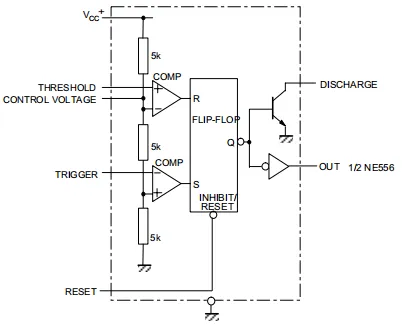556 Timer Circuits: Features, Specification and Applications
In addition to being used as a timer, 555 timer ICs are used in various applications such as oscillators, pulse generators, and multivibrators. An accurate timing pulse can be produced by this highly stable controller. One external resistor and one capacitor control the delay in mono-stable operation. By using two resistors and one capacitor, astable operation accurately controls frequency and duty cycle.
The article will cover all the characteristics, applications, and pin connections of 556 circuits. In addition, you will learn how to construct a simple 556 circuit that is useful for electronic circuits.
Pin Configuration and Connection
In order to understand 556 circuits, you must also know how they are connected. Each 555 pin on a 556 chip is parallel to the other. Pins 1 to 3 comprise the power supply pin (V+), ground pin (V-), and threshold voltage adjuster pins (output enabled pins). They also provide adequate voltage for the circuit's operation, as well as grounding it for proper operation.
-
Pin 2 and 12; gateways at the end of timing intervals.
-
Pin 14; controls the voltage supply (+Ve, ranging from 3 to 15 volts).
-
Pin 4 and 10; used to reset the timing interval period of dual timers
-
Pin 7; Ground(0 Volts)
-
Pin 3 and 11; control the pulse width with the voltage divider in dual timer mode. When in single timer mode, it also functions as a reset input.
-
Pin6 and 8; initiate timing interval process with external/internal clock input.
-
Pin 1 and 13; used as outputs once the reset line is signaled. Furthermore, they can discharge capacitors periodically.
-
Pin 5 and 9; output pins for dual timers. In addition, these pins are connected to components whose voltage or current needs to be switched.
556 circuits require understanding which pins are used for inputs and which are used for outputs. The course can then be easily troubleshooted and fixed in the event of an issue. Depending on the project requirements, 556 circuits can be arranged in a number of different ways. The following are among them:
-
Single timer mode.
-
Timer with dual adjustable pulse generation widths (shared clock input for both 555's).
-
Timer with two fixed pulse widths (both 555's have independent control inputs that are disabled when the common clock is enabled or disabled).
-
A pair of pulse width timer circuits with adjustable pulse widths.
Several different circuit configurations are possible with 556 circuits, including oscillators, timing functions, power-saving features, etc.!
556 Timer Circuits Features
The 556 timer IC (Integrated Circuit) is a versatile chip commonly used in electronics for generating precise timing pulses, oscillations, and time delays. An enhanced amount of functionality and flexibility is provided by integrating two 555 timer circuits into a single package. A detailed description of the 556 timer circuit is provided below:
Dual Timers: Two 555 timer circuits are contained within one package, both labeled Timer A and Timer B. Timer operations can be conducted simultaneously or sequentially, as each timer operates independently.
Wide Operating Voltage Range: Typically operating between 4.5 volts and 15 volts, the 556 timer can be used with a wide range of power supplies.
High Output Current: It is possible to drive external loads such as LEDs, relays, and small motors directly using the output stages of the 556 timer circuits, typically up to 200 mA.
Adjustable Timing: In both timers, pulse width, frequency, and delay periods can be adjusted through external resistors and capacitors.
Trigger and Reset Inputs: For initiating timing cycles and resetting the output, each timer includes trigger and reset inputs. Signals can be input digitally or analog, allowing for flexibility in triggering methods.
Output Polarity Selection: In order to enhance compatibility with a variety of interfacing requirements, the output of each timer may be configured to drive active-low or active-high signals.
Low Power Consumption: With low power consumption, these timer circuits are ideal for battery-powered applications or environments that require high power efficiency.
Temperature Stability: Its good temperature stability ensures consistent timing performance across a wide range of environmental conditions, making the 556 IC a suitable choice for low-power applications.
Flexible Package Options: In addition to DIP and SOIC package types, the 556 timer IC is offered in a variety of mounting and assembly options.
NE556 Design
Understanding the pinout, functionality, and configuration of NE556, a dual version of the popular 555 timer IC, is important for designing with it.
Symbol of 556 Circuit
3D Model
Alt Text: NE556 Schematic Diagram
556 Block Diagram
556 Timer Applications
Its versatility and reliability make the NE556 timer IC an extremely useful part in many electronic applications. NE556 timer circuits are commonly used for the following applications:
Pulse Generation:
A trigger signal triggers the NE556 to produce pulses of a precise duration in monostable mode. These pulses are used in electronic systems for precise timing, for controlling operations durations, generating synchronization signals, or generating synchronization signals. NE556 monostable circuits can, for example, trigger the actuation of a robotic arm for a specified duration in robotics.
Oscillator Circuits:
Astable Mode: A NE556 configured in astable mode produces continuous square wave output signals when configured in oscillator mode. A periodic signal source, such as a clock signal, can be generated by these oscillators for use in digital circuits or in alarm systems or notification systems. NE556 astable circuits can be used to drive electronic doorbells using periodic oscillations to simulate the sound of the doorbell.
Audio Applications:
The NE556 allows the generation of tones, the modulation of voice, and the processing of audio signals. Audio equipment, communication devices, and electronic musical instruments use these circuits. It is possible to compose melodies and music compositions using NE556 timer circuits in electronic keyboards, for example.
Motor Control:
Motor control circuits use NE556 timers for various purposes, including speed control, direction control, and timing of motor movements. Circuits like these are essential for robots, automated systems, and industrial control systems that require precise motor behavior control. As an example, NE556 timer circuits enable efficient material handling in factories and warehouses by controlling conveyor motors at the start, stop, and direction.
Time Delay Circuits:
Monostable Mode: Time-delay circuits often use NE556 timers in order to delay an action until a particular event occurs. This can be used for a variety of purposes, including debouncing switches, initiating sequential processes in industrial processes, and delaying activation of devices. A monostable NE556 circuit, for example, can trigger a camera shutter after detecting motion with a precise delay following the detection of movement in photography.
Flip-Flops and Counters:
Bistable Mode: It is possible to use the NE556 timer as a flip-flop or binary counter in bistable mode. A digital system can use these circuits to store memories, divide frequencies, or control sequentially. A NE556 bistable circuit can, for example, be used to store sensor states (e.g., door sensors) and control alarm activation based on those states.
NE556 Alternatives Component
NE556 is an excellent timer circuit component because of its versatility and dual timer capabilities. Nevertheless, alternatives are available that are able to fulfill similar functions. The NE556 can be replaced with the following alternatives:
NE556: Where to Buy?
Amazon and eBay are two places where you can purchase NE556 online. Moreover, you can also get this component from our website. You can also check the updated datasheet and many other things on the website too. . We regularly update and supplement our information.
Welcome to Blikai RFQ page: https://www.blikai.com/rfq
Faqs
How do you use a 556 timer chip?
The output pin of the first 555 timer is connected to the trigger pin of the second 555 timer when using a 556 dual timer in monostable mode (one-shot). Following that, the second timer is triggered when the first timer's output is low.
What is a 556 timer IC?
Dual 555 timer circuits are integrated into a single package in the 556 timer IC, which is a dual version of the popular 555 timer IC. Two timers can be operated simultaneously or independently, offering dual functionality.
Final Verdict
556 timer circuits can be used for generating pulses, controlling electronics, and timing a variety of applications. The 556 timer provides convenience and flexibility in timing functions with dual timer functionality and support for monostable, astable, and bistable modes of operation.
Among its many uses are digital electronics, automation, communication, and instrumentation because the 556 timer is capable of generating precise pulses, controlling oscillations, and creating time delays. Furthermore, it is compatible with a wide range of temperature conditions, has a high output current capability, and can operate over a wide voltage range.
556 timer circuits represent a convenient and versatile component option that can be integrated into countless electronic projects and systems, providing designers with dual timers in a single package.
Microprocessor Vs Integrated Circuit: What’s the Differences?
What is an Integrated Circuit (IC)? Working, and Types (Guide)
What Integrated Amplifier Is and How It Works
Air Conditioner Capacitor Basics: What You Need to Know
Impact of IRF3205 MOSFET on Power Electronics: Advancements and Applications
CR1632 Equivalent: Applications, Features and Characteristics
Chip Resistor: characteristics, Applications & Advantages
DIY Electronics Project for Beginners: Pick the Best One for You
Phototransistor : Circuit Pinout & Principle
Watt Amplifier Circuit:Types,Principle and Applications













